Shrubby St. Johnswort (
Hypericum prolificum) combines a long bloom cycle with four-season interest, compact form, low maintenance and tolerance for a wide range of growing conditions, making it one of the best woody St. Johnsworts native to North America. This shrub is not to be confused with common St. Johnswort (
H. perforatum), a sometimes invasive perennial herb that is native to Europe and the main source for the herbal supplement by the same name.
Caution: Shrubby St. Johnswort is considered invasive in some New England states.
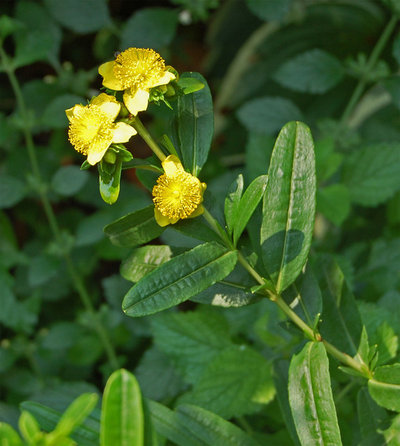
Worldwide, there are more than 400 species of St. Johnswort in the genus
Hypericum. These range from trees to small, sometimes weedy, herbs. Most of these have bright yellow flowers that have a profusion of stamens exploding from the center of the bloom.
Botanical name: Hypericum prolificumCommon names: Shrubby St. Johnswort, shrubby St. John’s wort, shrubby St. John’s-wort
Origin: Its original native range was from New York to Michigan and southward to Georgia and Louisiana, but it has since escaped from cultivation in adjoining states and can be found growing in the wild from southern Maine to northern Florida and as far west as eastern Texas. It is considered invasive in some New England states.
Where it will grow: Hardy to minus 30 degrees Fahrenheit, or minus 34.4 degrees Celsius (USDA zones 4 to 8; find your zone).
Typical plant communities: Upland fields and woodlands, rocky soils and stream banks
Water requirement: Moderately dry to moist soil
Light requirement: Full sun to part shade; shadier sites in hot climates
Shown: Bright yellow flowers dominated by a mass of stamens are the signature of
Hypericum. The species name
prolificum refers to the prolific number of stamens in its flowers.
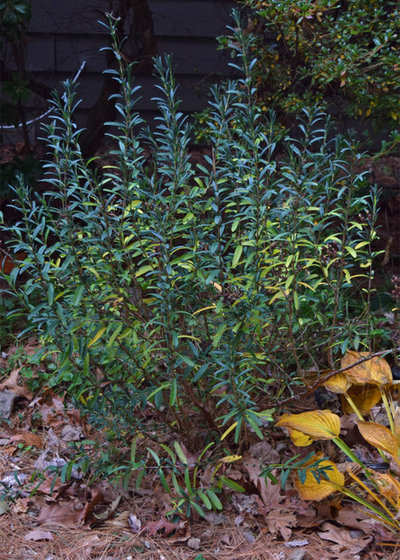 Mature size:
Mature size: 2 to 4 feet tall and wide
Benefits and tolerances: Shrubby St. Johnswort tolerates clay and alkaline soil, salt spray, flooding and periods of drought. Deer usually avoid it, and it grows well under black walnut trees.
Seasonal interest: Its bloom cycle extends from late June through August; flowers open a few at a time so that the season is spread out. The plant is evergreen in zones 6 and warmer, though it holds its leaves tightly to the branches in winter. The bark on older branches peels off, revealing the light brown to orange inner bark. The seed capsules hang on over the winter, providing additional interest.
When to plant: Plant containers from spring to fall as long as sufficient moisture is provided during hot or dry spells. Shrubby St. Johnswort is also easy to grow from seed; germination occurs when temperatures reach 70 degrees Fahrenheit (21.1 degrees Celsius).
Shown: This photo taken in mid-November highlights the shrub’s upright form. The upper leaves may be retained over the winter.
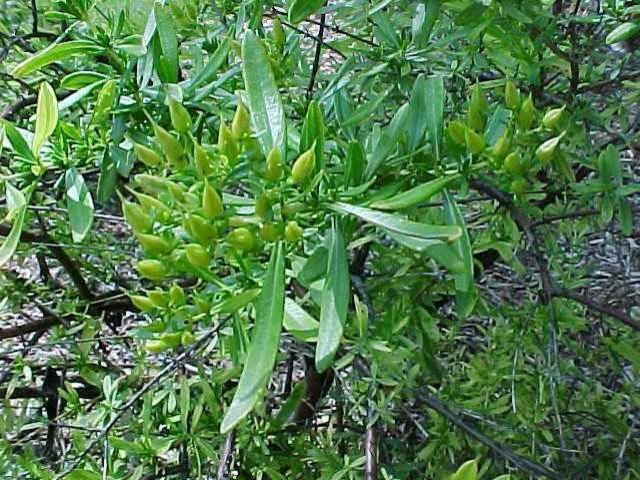
Missouri Botanical Garden
This older specimen displays a large number of flower buds, which will open sequentially through July and into August.
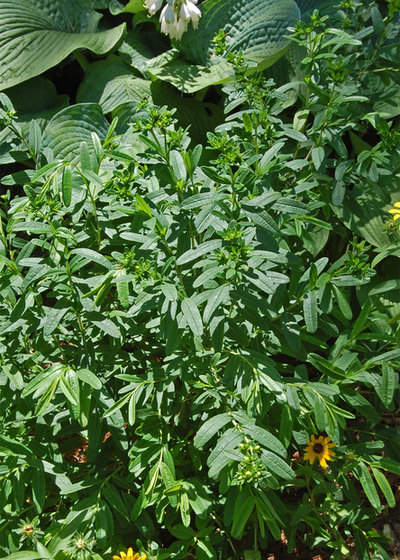 Distinguishing traits.
Distinguishing traits. Bright yellow flowers, about three-quarters to 1 inch across, with a multitude of protruding stamens resemble starbursts and appear throughout summer. Narrow leaves, about 2 to 3 inches long, are paired on opposite sides of the stems. Each pair is offset by about 90 degrees moving along the stem. This imparts a definite texture to the shrub, different from many other landscape plants. The conical seed capsules are mostly three-valved (have three equal segments). These split open in autumn to release the small seeds and are retained on the plant all winter.
In the first week of summer before the flowers open, you can see how the texture of the
Hypericum contrasts with the large-leaved hosta. Even though each has a similar blue-green leaf tone, the textural difference shows these as two distinct plants.
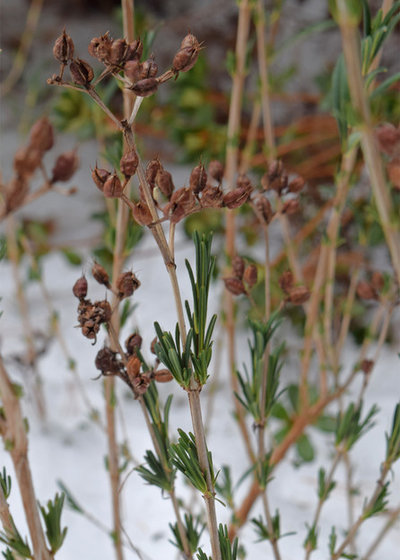 How to use it.
How to use it. With its dense branching and upright form, shrubby St. Johnswort is a useful small shrub in a low-maintenance hedge or along a pathway. I like using it in the middle of a planting. Growing typically to 2 to 4 feet tall and wide, it nicely fills in the space between low-growing perennials and larger background shrubs and trees.
Blooming in midsummer, it provides color after most other shrubs are done flowering. Since it tolerates alkaline soils, it does well near concrete structures and foundations. Its fibrous root system does a good job of holding soil and preventing erosion. It tolerates a range of soil moisture, including flooding, making it a good candidate for a rain garden.
Shown: Empty seed capsules add winter interest, and evergreen leaves cling to the stems.
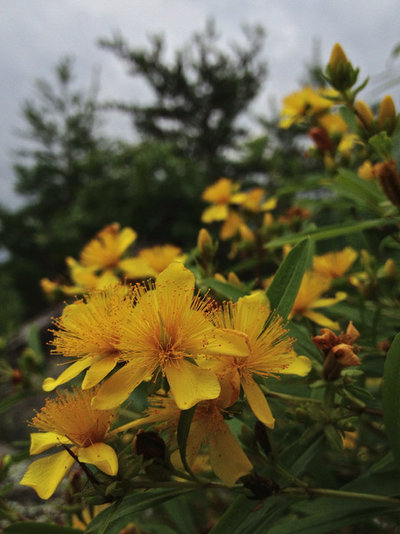 Planting notes.
Planting notes. This plant is available as seeds, bare-root and in containers from several online and mail-order nurseries. It may also be available from nurseries featuring native species and at native plant sales.
Shrubby St. Johnswort is not very particular about soil conditions. Its fibrous root system allows for easy transplanting. Under ideal growing conditions, it can become weedy through the dispersal of its seeds. It is generally problem-free except in hot and humid environments, where root rot and wilt can occur. The flowers form on new wood, so pruning is best done in early spring before growth begins. Sow seeds on the surface of the soil — they need light to induce germination. Better rates of germination may result from cold, moist storage of the seeds for three months before sowing under lights.
The flowers are great sources of pollen for native bumblebees. The flowers produce no nectar, so visits by butterflies are rare. The shrubs, however, are a larval host plant for the gray hairstreak butterfly (
Strymon melinus).
Photo by Fritz Flohr ReynoldsBrowse more native plants by region





